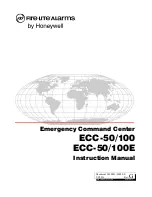
When you press star (*) on the dial pad with the cursor in one of the three fields towards the left of
the display, the following happens:
• The field where you are trying to enter a value displays a zero if no value is entered.
• If you enter a valid value a period displays. The space after the field displays a period.
• The cursor moves to the next space.
When you press star (*) with the cursor in one of the three fields to the right side of the display, the
system beeps to indicate an error and the cursor remains in the field to the right. Pressing the “*”
button while the cursor is in the last (right most) field results in an error beep and the cursor being
left where it is. If you enter all three dots that separate the fields and if the value of each field is
valid, the IPv4 address or subnet mask is complete.
The value of a given field might be invalid when you:
• Enter a digit that makes the value of the first field of an IPv4 address exceed 255.
• Enter a digit that makes the value of the last three fields of an IPv4 address exceed 255.
• Enter a digit that makes the value of any field of a subnet mask exceed 255.
Enter an IPv6 address using only numbers on the dial pad. When you press
2
the deskphone
initially enters a 2, followed by A, B, C, and back to 2. When you press
3
the deskphone initially
enters a
3
, followed by D, E, F, and back to
3
. While the cursor is in any of the left most seven
fields, when you press the star (*) button makes the value for the field being entered to be
terminated (a zero is displayed if nothing else is), a colon to be displayed in the space after the
field, and the cursor to move to the next space. Pressing “*” while the cursor is in the last (right
most) field results in an error beep and the cursor being left where it is. An IPv6 address is
considered to be complete only if all the following conditions are met:
• All seven colons that separate the fields are entered OR the text input field contains at most
one pair of consecutive colons
• If one pair of consecutive colons is present, the final field is not “1” or “01”.
• If one pair of consecutive colons is present, the address format is not “::FFFF:hhhh;hhhh”.
• The value of each field is valid. The following actions cause the value of a given field to be
considered invalid:
- Entering a digit that would cause the value of the first field of an IPv6 address to exceed
FD.
- Entering a third consecutive colon.
- Entering a second pair of consecutive colons.
In a given text entry field, if the either an IPv4 or an IPv6 address can be specified, the initial field
can be ambiguous with respect to whether the entry is an IPv4 or IPV6 address, for example,
123
might be an IPv4
123 decimal
or an IPv6
0123 hex
. In such cases, text entry follows the IPv6 rules
that hexadecimal characters are allowed and the “*” key inserts a colon character. If the entry is a
hex character (A-F) or a fourth character is entered in the field, the telephone accepts the input is
IPv6 format. Otherwise, the telephone makes the initial validity check when you enter a field
boundary, a colon or decimal point. This initial typographic character determines whether the
overall address must be in IPv4 format with a decimal point or in IPv6 format with a colon. Once
Using local Administrative Menu procedures
May 2018
Installing and Administering Avaya J169/J179 IP Phone H.323
33
















































